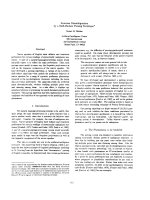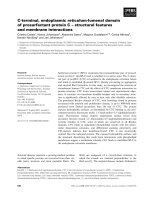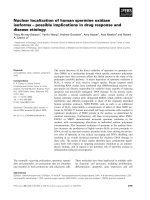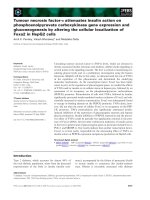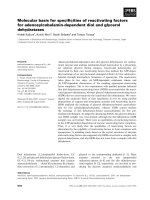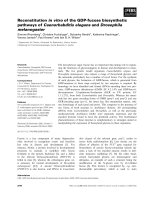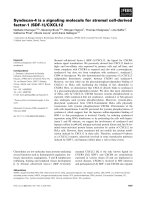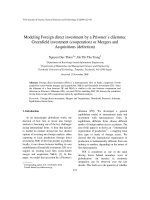Báo cáo " Modeling Foreign direct investment by a Prisoner’s dilemma: Greenfield investment (cooperation) or Mergers and Acquisitions (defection) " pptx
Bạn đang xem bản rút gọn của tài liệu. Xem và tải ngay bản đầy đủ của tài liệu tại đây (169.89 KB, 9 trang )
VNU Journal of Science, Natural Sciences and Technology 25 (2009) 123-131
123
Modeling Foreign direct investment by a Prisoner’s dilemma:
Greenfield investment (cooperation) or Mergers and
Acquisitions (defection)
Nguyen Duc Thien
1,
*, Ha Thi Thu Trang
2
1
Department of Knowledge-based Information Engineering
2
Department of Humanities and Management Science and Engineering
Toyohashi University of Technology, Tempaku, Toyohashi, 441-8580 Japan
Received 13 November 2008
Abstract. Foreign direct investment (FDI) is a heterogeneous flow of funds, composed of both
acquisition (cross-border mergers and acquisitions, M&A) and Greenfield investment (GF). Since
the dilemma of a firm between GF and M&A is similar to the one between cooperation and
defection in Prisoner’s Dilemma (PD), we used PD for modeling FDI. We discuss the conditions
for the firms to take GF (cooperation) option by equilibrium analysis
Keywords: Foreign direct investment, Mergers and Acquisitions, Greenfield, Prisoner’s dilemma,
Equilibrium, Game theory
1. Introduction
∗
∗∗
∗
In an increasingly globalized world, the
decision of how best to invest into foreign
markets is becoming one of the key challenges
facing international firms. A firm that decides
to market its product abroad has two distinct
options of investing into foreign markets: either
exporting or local production (foreign direct
investment, FDI). If the firm decides to produce
locally, it can choose between building its own
establishment (Greenfield investment, GF) or to
acquire an existing local firm (cross-border
merger and acquisition, M&A) [1]. In this
paper, we model that accession by a Prisoner’s
_______
∗
Corresponding author. Tel.: 81-90-8457-8324.
E-mail:
dilemma (PD). We developed a general
equilibrium model of international trade and
investment with heterogeneous firms. In
equilibrium, different firms choose different
modes of foreign market access as players. The
aim of this paper is to derive an “international
organization of production”: a mapping from
firm type to mode of foreign access. We
showed that the international organization of
production is fundamentally different from one
industry to another, depending on the nature of
firm heterogeneity.
FDI is considered as one of the main
driving forces behind nowadays wave of
globalization. An increase in economic
integration can be observed over the last
decade. This leads us to the question of whether
N.D. Thien, H.T.T. Trang / VNU Journal of Science, Natural Sciences and Technology 25 (2009) 123-131
124
or not economic integration may trigger FDI,
and if that is the case, which strategy that
international firms should use when investing
into new markets [2]. We examine many firm
type models, as players’ action, to find the best
strategy that the firms should use – M&A or
GF– by comparing their profitability in each
different possibility.
FDI is defined as an investment that
involves a long-term relationship and reflects a
lasting interest and control by a firm in one
country (investor) in an enterprise resident in an
economy other than that of the investor. There
are different ways a firm can enter a foreign
market. We focused on two types of business
strategy to conduct FDI: they can either acquire
an existing firm in the host country through
M&A or they can set up a new venture in
another country by choosing GF as an option.
The firm’s decision may be influenced, among
other things, by the entry costs to a foreign
market, especially trade and investment costs
[3].
Over the last decades, there have been
several waves of increased activity in FDI. Each
of those waves has its own characteristics. In
the 1970s, for example, international firms
mainly tried to achieve economies of scale. In
the 1980s, the priority was to gain from the
synergy effects, especially in the single market
of the European Union (EU merger control act).
Since mid 1990s, an unprecedented wave of
FDI can be observed with its latest peak at the
beginning of the 21st century, characterized by
deregulated and growing markets from
globalization.
In the next sections, this paper is structured
as follows. Part 2 presents a brief overview of
the FDI in the PD model. First, PD model in
general context is introduced. Then, GF vs.
M&A in FDI is shown. The application of the
model is presented in part 3. We also discussed
the conditions for the firms to take GF
(cooperation) by equilibrium analysis. Finally,
the paper is concluded in part 4.
2. The FDI in the Prisoner’s dilemma
2.1. The Prisoner’s dilemma
Two individuals are arrested for engaging in
a serious crime and are held in separate cells.
The police try to extract a confession from each
person. Each is privately sentence. If both
confess they will get 3 years sentence. If neither
confesses they will get 1 year sentence. If one
of them confess, he will get free, other person
will get 5 years sentence.
PD is a game played once by two players
with two available actions: cooperation C, or
defect D.
Table 1. The payoff matrix of the PD game
Player 2
C D
C
R,R S,T
Player 1
D
T,S P,P
If both cooperate, their payoff R (reward) is
higher than the payoff P (punishment) obtained
if both defect. But if one player defects while
the other cooperates, then tie defector’s payoff
T (temptation) is higher than R, while the
cooperator’s payoff S (sucker) is smaller than
P.
SPRT
>
>
>
(1)
It is furthermore assumed that:
STR
+
>
2
(2)
N.D. Thien, H.T.T. Trang / VNU Journal of Science, Natural Sciences and Technology 25 (2009) 123-131
125
Table 2. PD payoffs with T=5, R=3, P=1 and S=0
Player 2
C D
C
3,3 0,5
Player 1
D
5,0 1,1
So that joint cooperation is more profitable
than alternating C and D.
Player has an action and a strategy. He (and
hence the strategy) plays PD with opponent,
and changes his action according to the total
score that he receive [4]. In the future model,
we will propose the strategy determines the
next action depending on the result of logical
function of the opponent in two last actions.
2.2. Greenfield vs Mergers&Acquisitions in PD
In this model, we try to answer the question
when firms should use M&A or GF as a form
of entry mode into another country’s market.
The model demonstrates the synergy effects of
increased competition on the profitability of
M&A. Further, the effects of entry costs on the
firms’ profitability are taken into account. This
allows conclusions about which form of entry
should be preferred.
In recent years, the globalization of firms
has assumed two new features. First, firms
increasingly enter foreign markets by acquiring
a local producer (M&A) instead of opening a
new subsidiary (GF). The phenomenon is
particularly apparent in industrialized host
countries, where the bulk of FDI inflows enter
trough M&A. Second, the interaction between
the international strategy and the innovative
activity of firms has become increasingly
rigorous and complex, due to the key role of
multinational companies in the process of
generation and transfer of technology and
knowledge in the global market [5]. Models
therefore should take into account for features
which nowadays characterize the
internationalization process, capturing the
technological implications of M&A.
At first, we consider a situation with two
firms, firm A and firm B invest together to firm
X by any merger activity. In the benchmark
case both firms have identical technologies and
marginal production costs. Firm X is the target
firm, located in country Y, whereas firm A and
B are the foreign firms located outside country
Y. These two foreign firms consider how to
enter country Y’s market. In modeling by PD,
GF investment count as cooperation (C) and
M&A count as defection (D), respectively.
Because M&A allows a firm to get costly
access to the country-specific capabilities of the
acquired firm, and the price of such an M&A is
governed by demand and supply of firms in the
market for corporate control. In contrast, by
engaging in Greenfield FDI, a firm brings only
its own capabilities to work abroad. If a firm
enters the foreign market through GF, it has to
pay a fixed investment cost and its technology
level is reduced in the foreign market due to
technology transfer costs. If a firm enters
through M&A, it must offer the other firm a
sufficiently high M&A price in order to get an
acceptance. If the bid is accepted through a
bargaining process, the acquirer becomes a
monopolist in both markets and will gain from
synergy effects that improve productivity. The
payoff matrix of how the foreign firms can
enter and afterwards serve the domestic market
as the PD model:
N.D. Thien, H.T.T. Trang / VNU Journal of Science, Natural Sciences and Technology 25 (2009) 123-131
126
Table 3. The payoff matrix of two firms invest to
firm X
Firms 2
GF M&A
GF Holding Absorption
Firms 1
M&A Preservation Symbiosis
Each firm, as a player has two actions,
M&A or GF. With payoff Holding, both GF,
firms allow little autonomy - yet do not
integrate the target into its businesses. With
payoff Absorption, one player GF while other
M&A, firms completely absorb the target firm.
If the target firm is large, this can take time.
With payoff Preservation, one player M&A
while other GF, firms make very few changes
to the target, and instead learned from it in
preparation for future growth. Finally, with
payoff Symbiosis, both players M&A, they
integrate the target in order to achieve synergies
- but allows for autonomy, for example to retain
and motivate employees. This is possibly the
most difficult to implement.
The payoff functions for the players capture
the consequences that any given choice of
actions has for each player. It is assumed that
players have complete information, so that once
a pair of actions is chosen, the objective
function for each player maps these into a
payoff. The actions of the foreign firm can
affect domestic firm and themselves, the firm's
payoff function in the FDI game takes on this
table.
3. Modeling
The payoff of both firms:
Table 4. General payoff matrix of a PD game
Firm B
GF M&A
GF
R
1
,R
2
S,T
Firm A
M&A
T,S P
1
,P
2
In the PD, R
1
=R
2
, they become R. Similarly,
P
1
=P
2
, become P:
Table 5. Reduced payoff matrix of a PD game
Firm B
GF M&A
GF
R S,T
Firm A
M&A
T,S P
The profits of the two firms vary depending
on the market configurations. Four possible
market configurations may arise:
Table 6. Four possible market configurations of
modeling to the PD game
R= (GF, GF)
We have both firms
undertake Greenfield FDI
S= (GF, M&A)
Firm A undertakes a
Greenfield FDI while
firm B M&A
T= (M&A, GF)
Firm A undertakes a
M&A while firm B GF
P= (M&A, M&A)
We have both firms
undertake M&A
Both firms introduce cost saving
innovations. We assume that a total knowledge
pool is divided between the two choices in
proportion k for M&A and (1-k) for GF
N.D. Thien, H.T.T. Trang / VNU Journal of Science, Natural Sciences and Technology 25 (2009) 123-131
127
with
[
]
5.0 ,0∈k
. Therefore, knowledge pool cost
of GF is always greater than M&A.
We hold that unit variable of production
cost depends on firm's exogenous cost,
including technological reduction Based on [3],
with the unit variable p
A
, p
B
for firm A and firm
B, respectively, the total costs are given by:
AAM
pkc +=
&
(3)
BGF
pkc +−= 1
(4)
The costs of internal knowledge transfer are
inversely proportional to the parameter
]1,0[
∈
t
.
Due to absence of external knowledge transfer,
we have:
AAM
ptkc +=
&
(5)
BGF
pktc +−= )1(
(6)
In addition, a cross border M&A has
important technological implications which
decrease the firm’s cost of production. The unit
production cost in M&A is:
))1((
&
kkeptkc
AAM
−++=
(7)
The parameter e is considered synergy
effect when a firm makes M&A.
If a firm chooses to enter a foreign market
through GF it faces a fixed cost F as a new
production unit should be built:
Fpktc
BGF
++−= )1(
(8)
We call the parameter
1
≥
w
measures the
size of the world market while the parameter
[
]
0.5 ,0∈s
indicates the share of the world
market accounted for GF and thus
-s)(1
the
share accounted for by M&A.
The profits were calculated by sales minus
cost. Thus the payoff functions profit for each
of these market structures are reported as:
(
)
Fp-k)t(wsR
B
++−= 1
(9)
(
)
ekptkwsS
A
++−=
(10)
(
)
Fp-k)t(swT
B
++−−= 1)1(
(11)
(
)
ekptkswP
A
++−−= )1(
(12)
Eq. 9 – Eq. 12 to satisfy the condition in the
PD in Eq. 1:
SPRT
>
>
>
and Eq. 2: 2R>T+ S
The optimal foreign entry mode is found by
solving a two stage game. In the first stage,
firms choose the mode of entry, while in the
second they decide the profit maximizing level
of output. As usual, the game is solved
backwards. Cournot-Nash equilibrium for sales
is thus computed first, with the levels of
optimal sales computed for each market
configuration. The first stage is then solved,
with firms choosing between GF and M&A. We
first find the PD solution of the constrained
game with strategy space S= {GF, M&A}. Then
we solve the acquisition decision by applying
the Nash fixed-threat bargaining equilibrium
concept.
The equilibrium mode of entry: The PD
game with S= {GF, M&A}
We shall now discuss how the firms will
make their choices, regarding the mode of
foreign expansion. Before addressing the M&A
decision, we should determine the solution of
the PD game with strategy space S= {GF,
M&A}. In this way, we determine what will be
the equilibrium mode of entry if the acquisition
does not take place. In order to analyze the
N.D. Thien, H.T.T. Trang / VNU Journal of Science, Natural Sciences and Technology 25 (2009) 123-131
128
choice between GF and M&A, we need to know
the profits of each firm corresponding to the
different possible market configurations. Then
we have to obtain the Nash equilibrium solution
of a matrix game between the two firms where
the payoffs are the equilibrium profits of each
single firm.
The equilibrium profits for each market
configurations, obtained by substituting in
equations 9-12 the optimal sales we get by
solving the second stage games, based on [3]
are:
(
)
(
)
F
p-k)t(ws
R
B
−
+−
=
4
1
ˆ
2
(13)
(
)
(
)
9
ˆ
2
ekptkws
S
A
++−
=
(14)
(
)
(
)
F
p-k)t(sw
T
B
−
+−−
=
9
1)1(
ˆ
2
(15)
(
)
(
)
9
)1(
ˆ
2
ekptksw
P
A
++−−
=
(16)
By comparing the profit functions under
alternative strategy combinations, we can
identify the conditions for the firm to take
dominant strategies with 0
ˆ
>R and 0
ˆ
>P :
(
)
(
)
F
p-k)t(ws
B
>
+−
4
1
2
(17)
(
)
(
)
0
9
)1(
2
>
++−− ekptksw
B
(18)
The Eq. 17 takes from Eq. 13. If Eq. 17
holds, M&A is the dominant strategy for firm A.
Otherwise, GF will be the dominant strategy.
Similarly, The Eq. 18 takes from Eq. 16. If Eq.
18 holds, M&A will be the dominant strategy
for firm B.
As to the effect of relative market size
(captured by the parameter s), the probability
that Eq. 17 (Eq. 18) holds and thus that firm A
(firm B) establishes a new subsidiary abroad is
decreasing (increasing) in s:
(
)
(
)
0
4
12
)17(
>
+
−
=
∂
∂
B
p-k)t(wsw
s
LHS
(19)
(
)
(
)
0
9
)1(2
)18(
<
+
+
−
−
−=
∂
∂
ekptksww
s
LHS
A
(20)
This finding reminds us that a large host
market is an important attractor for inward FDI
since it will imply higher variable profits,
making it easier to compensate for the
additional fixed plant costs associated to a GF.
Synergy effects is more powerful the larger the
size of the overall market (that is the higher the
parameter w).
Eq. 19 and Eq. 20 can be rearranged
respectively as:
k
w
t
w
pt
w
s
B
−
+
+>
2
2
(23)
k
w
et
w
p
w
s
A
−
−+−<
2
2
9
1
(24)
Fig 1 and Fig 2 illustrates how the
equilibrium strategy choice depends on the
value of s and t, where the size of the world
market (w) is set to 3 in Fig 1 and 5 in Fig 2
respectively.
N.D. Thien, H.T.T. Trang / VNU Journal of Science, Natural Sciences and Technology 25 (2009) 123-131
129
The red line in figures 1 and 2 represents
the condition in Eq. 19 with strict equality,
whereas the blue line represents the condition in
Eq. 20. In this case, where firm A has a
technology advantage, and its foreign market is
relatively large (Region R of diagrams), it will
chose GF while firm B will chose M&A. By
symmetry, the opposite strategies are chosen in
the region P of the diagrams. When w is
reduced, these two indifference lines shift
upwards and downwards respectively, and
when they shift positions, the equilibrium shifts
from R=(GF, GF) and P=(M&A, M&A) in
Figure 1 and 2 expand, otherwise, T=(GF,
M&A) and S=(M&A, GF,) retract. Since the
two indifference lines are always parallel (Fig
3), no parameter combination allows both
R=(GF, GF) and P=(M&A, M&A) to be
equilibrium within the feasible (s,k) space.
As to technological asymmetry (captured by
the parameter k), the probability that Eq. 17
(Eq. 18) holds and thus that firm A (firm B)
establishes a new subsidiary abroad is
increasing (decreasing) in k:
(
)
(
)
0
4
12)17(
2
>
+
−
=
∂
∂
p-k)t(w.s
t
k
LHS
(21)
k
w
t
w
pt
w
s
B
−
+
+=
2
2
k
w
et
w
p
w
s
A
−
−+−=
2
2
9
1
Fig. 3. Equilibrium outcomes in the (s,k) plan
with t=0.3; p
A
=0.01; p
B
=0.2; e=0; and w=5
k
w
t
w
pt
w
s
B
−
+
+=
2
2
k
w
et
w
p
w
s
A
−
−+−=
2
2
9
1
Fig. 2. Regions defining equilibrium outcomes in
the (s k) plan with t=0.3; pA=0.01; pB=0.2; e=2;
and w=3 in Eq. 24
k
w
t
w
pt
w
s
B
−
+
+=
2
2
k
w
et
w
p
w
s
A
−
−+−=
2
2
9
1
Fig. 1. Regions defining equilibrium outcomes in
the (s,k) plan with t=0.3; p
A
=0.01; p
B
=0.2; e=2;
and w=5 in Eq. 23
N.D. Thien, H.T.T. Trang / VNU Journal of Science, Natural Sciences and Technology 25 (2009) 123-131
130
(
)
(
)
0
9
1)1(2)18(
2
<
+
−
−
−=
∂
∂
p-k)t(sw
t
k
LHS
(22)
This suggests that the technologically
leading firm is more likely to expand abroad
than the weaker competitor. Its unit variable
cost advantage implies that by producing
abroad, it will enjoy –ceteris paribus- higher
variable profits than its competitor. The
advantage of the leading firm is greater with the
lower the cost of cross border internal
technology transfer (the higher t is), since low
internal technology transfer costs imply that the
leading firm will benefit more in the foreign
market from its technological leadership. The
equilibrium strategy configuration clearly
depends on values of the parameters.
5. Conclusion
In the literature of theoretical industrial
organization, study of why firms decide to enter
a foreign market through GF or M&A is at
initial stage. So far, not many studies have
succeeded in identifying what kind of firms
chooses to make a cross border M&A, and what
kind of firms choose instead to be acquired by
foreign firms. Our analysis shows that the
acquiring firm always gains the highest profit if
an acquisition was not possible.
In fact, we find that the equilibrium
acquisition price reflects the target firm
potential for growth. We show that an
acquisition must generate strong synergy effects
to be more profitable than a strategy where both
firms remain purely national. However, a
prisoner’s dilemma structure may force both
firms to GF, and in that case, an M&A may be
more profitable even without synergy effects.
We considered both the gains from
implementing a best practiced technology and
potential synergy effects, in addition to
knowledge transfer costs and acquisition costs
associated with a merger. Empirical studies
show that such acquisition costs can be
surprisingly high, leading to low profits from
acquisitions.
In this paper, we applied a simple
bargaining model to determine the identity of
the acquirer. Our model contains important
features that play a pivotal role in deciding the
investment choice between conducting an
acquisition M&A and establishing a new
subsidiary through GF. In our model, we
characterized GF choice as cooperation, and
M&A choice as defection in the Prisoner’s
dilemma problem.
In future works, we consider a new strategy
in FDI game by spatial prisoner’s dilemma, the
logical function strategies which take into
account two last actions of the opponents
instead of one in Tit-for-tat.
Acknowledgments
This work was supported in part by The
Japan International Cooperation Agency (JICA).
We would like to especially thank Prof. Ishida
Yoshiteru. We would also like to thank Mr.
Tokumistu Masahito, Mr. Katsumata Yuji and
participants at The 4th Vietnamese-Japanese
Students Scientific Exchange Conference
(Kyoto University, 2008) for helpful
discussions and comments.
References
[1] Volker Nocke and Stephen Yeaple, Cross-border
mergers and acquisitions vs. Greenfield foreign
N.D. Thien, H.T.T. Trang / VNU Journal of Science, Natural Sciences and Technology 25 (2009) 123-131
131
direct investment: The role of firm
heterogeneity, Journal of International
Economics 72 (2007) 2.
[2] Anne-wil Harzing, Acquisitions versus
Greenfield investments: International strategy
and management of entry modes, Strategic
Management Journal (2002) 2.
[3] Daniel Lenkeit, Modes of FDI: M&A versus
Greenfield investment, MAVG INVESTMENT:
2006, pp. 1-4.
[4] Yoshiteru Ishida and Toshikatsu Mori, Spatial
strategies in a generalized spatial prisoner’s
dilemma, Artif Life Robotics: pp. 1-3, 2005
[5] Leo Grunfeld and Francesca Sanna Randaccio,
Greenfield investment or Acquisition? Optimal
foreign entry mode with knowledge spillovers in
a cournot game, ETSG 7
th
Annual Conference:
2005, pp. 1-4.
Mô hình hóa ñầu tư FDI bằng mô hình Prisoner’s Dilemma:
ðầu tư từ ñầu (Hợp tác) hay Sát nhập (Bất hợp tác)
Nguyễn ðức Thiện
1
, Hà Thị Thư Trang
2
1
Khoa Thông tin Cơ sở Tri thức
2
Khoa Quản lý Khoa học và Công nghệ
Trường ðại học Công nghệ Toyohashi, Nhật Bản, Tempaku, Toyohashi, 441-8580 Japan
ðầu tư trực tiếp nước ngoài FDI là một luồng quỹ hỗn tạp, bao gồm cả mua bán/sát nhập (M&A)
hay ñầu tư từ ñầu (GF). Khi một công ty ñắn ño giữa hai lựa chọn trên cũng giống như trong mô hình
“sự lưỡng nan của hai người tù” (PD) trong lý thyết trò chơi. Chính vì lẽ ñó, chúng tôi ñã sử dụng mô
hình này ñể mô hình hóa ñầu tư trực tiếp nước ngoài. Các ñiều kiện khi một công ty lựa chọn ñầu tư từ
ñầu ñã ñược thảo luận bằng cách phân tích các trạng thái cân bằng.
Từ khóa: ðầu tư trực tiếp nước ngoài, mua bán/sát nhập, ñầu tư từ ñầu, sự lưỡng nan của hai người
tù, lý thyết trò chơi.


